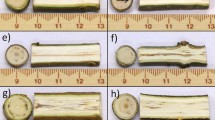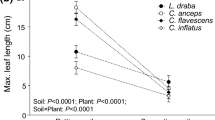Abstract
Cacao genotypes of various origins were evaluated for resistance to the cocoa mirid (Sahlbergella singularis (Haglund)) based on field damage, antixenosis, antibiosis and tolerance. Field damage was assessed by scoring recent and cumulative damage by the mirid to the major genetic groups of cacao. Antixenosis assessment was based on the number of feeding lesions on twig segments using a choice test. Antibiosis was measured through survival of young mirid nymphs on shoots and pods, whereas tolerance was assessed through the reaction of the twigs to mirid feeding punctures. Among the genetic groups of cocoa, the Upper Amazon, the materials from Guiana and hybrid genotypes were the least damaged by the mirids, both for recent and cumulative damage. The Catongo group was, by far, the most susceptible group with more than 50% of the canopy showing both recent dieback and cumulative canker damage. With regard to antixenosis, antibiosis and tolerance, significant differences (P < 0.05) were found between the genotypes. The least preferred clones sustained between 2 and 3 lesions compared with the most preferred ones with 6–8 lesions per twig segment. Clones UPA402, T79/501 and IMC67 gave the lowest rate of mirid nymph survival, indicating that they exhibit antibiosis. The clones PA107, SCA6 and C151-61 sustained high numbers of mirid feeding lesions and relatively high levels of shoot death, but have a good ability for re-growth and can be considered as tolerant genotypes.
Similar content being viewed by others
References
Braudeau J. (1969) Le cacaoyer. Techniques Agricoles et Productions Tropicales, Ed. G. P. Maisonneuve & larose. Paris. 304 pp.
Bruneau De Miré Ph. and Lotodé R. (1974) Comportement de familles hybrides de cacaoyers, soumises aux attaques d’Homoptères. Café, Cacao, Thé 18, 187–192.
Cochran W. G. and Cox G. M. (1957) Experimental Design. John Wiley & Sons, New York. 611 pp.
Coulibaly L.F. (2005) Résistance du cacaoyer aux mir ides: recherche de sources d’antixénose et d’antibiose chez 10 clones. Mémoire de DEA. UFR Biosciences, Université de Cocody, 41 pp.
Coulibaly N., N’Guessan F. K., Decazy B., Medus D., Aidara S. and Coulibaly A. (1998) Le Fumivap: une nouvelle technique d’application des produits chimi¬ques dans la lutte contre les mirides du cacaoyer en Côte d’ivoire. Agronomie Africaine 10, 23–31.
Cros E., Bastide P., N’guyen-Ban J. and Armengaud P. (1996) Sensibilité du Cacaoyer aux mirides: Recherche de marqueurs biochimiques, pp. 325–329. In Proceed¬ings of the 12th International Cocoa Reæarch Conference, 17–23 November 2006, Salvador. Bahia. Brésil. Cocoa Producers’ Alliance, Lagos, Nigeria. 1199 pp.
Crowdy S. H. (1947) Observations on the pathogenicity of Calonectria rigidiuscula (Berk & Br.) Sacc on Theobroma cacao. L. Annals of Applied Biology. 34, 45–59.
Decazy B. (1979) La lutte contre les capsides du cacaoyer au Cameroun: nouvelles données sur les insecticides thermcnebullsables. Café, Cacao, Thé 23, 187–192.
Decazy B. and Coulibaly N. (1981) Comportement de cultivars de cacaoyers à l’égard de quelques insectes déprédateurs: possibilité d’une sélection précoce des cacaoyers tolérants, pp. 685–688. In Proceedings of the 8th International Cocoa Research Conference, 18–23 October 1981, Cartagena, Colombia. 880 pp.
Decazy B. and Essono B. (1979) Tests de contrôle d’infestation et traitements antimirides. Café, Cacao, Thé 23, 35–42.
Decazy B. and Lotodé R. (1975) Comportement de familles hybrides de cacaoyers soumis aux attaques de Helopeltis Sign. Café, Cacao, Thé 19, 303–306.
Entwistle P. F. (1972) Pests of Cocoa. Longman Group Limited, London. 779 pp.
Eskes A., Engels J. M. M. and Lass R. A. (Eds) (2000) Working procedures for cocoa germplasm evaluation and selection. Proceedings cf the CFC/ICCO/IPGRI Project Workshop, 1–6 February 1998, Montpellier, France International Plant Genetic Resources Insti¬tute, Rome, Italy. 176 pp.
Gibbs D. G. and Pickett A. D. (1966) Feeding by Distantiella theobromae (Dist.) (Heteroptera: Miridae) on cocoa: the effects of water stress in the plant. Bulletin cf Entomological Research 57, 159–169.
Kay D. (1961) Die-back of cocoa. West African Cocoa Research Institute Technical Bulletin No. 8, 20 pp.
Kumar R. and Ansari A. K. (1974) Biology, immature stages and rearing of cocoa-capsids (Miridae: Hetero¬ptera). Zoological journal cf the Unnean Society 54, 1–29.
Lachenaud Ph. and Sallee B. (1993) Les cacaoyers spontanés de Guyane. Localisation, écologie et morphologie. Café, Cacao, Thé 37, 101–114.
Lavabre E. M. (1960) Recherches sur une méthode économique de contrôle des mirides du cacaoyer. Café, Cacao, Thé 4, 16–25.
Lavabre E. M. (1970) Insectes nuisibles des cultures tropicales. Techniques Agrkoles et Productions Tropicales. G.R Maisonneuve & Larose, Paris. 276 pp.
Lavabre E. M. (1977a) Importance économique des mirides dans la cacaoculture mondiale, pp. 139–153. In les mirides du cacaoyer. GP. Maisonneuve & La rosse, Paris.
Lavabre E. M. (1977b) Aperçu sur la résistance variétale, pp. 329–333. Les mirides du cacaoyer G. P. Maisonneuve & Larosse. Paris. 366 pp.
Marchait H. (1971) Efficacité des insecticides dans la lutte contre les mirides du cacaoyer au Ghana. Bulletin Phytosanitaire de la FAO, Rome 19, 97–109.
N’Guessan K. F., Eskes A. B. and Lachenaud. P. (2006) Résistance des principaux groupes génétiques de cacaoyer (Theobroma cacao) aux mirides (Sahbergella singularis) en Côte d’ivoire. Sci. Nat. 36(1), 19–27.
Nguj’en-Ban J. (1971) Progrès récents dans la lutte chimique contre les mirides du cacaoj’er. Ccfé, Cacao, Thé 15, 129–134.
Nguj’en-Ban J. (1993) Nouvelle technique de sélection de cacaoj-ers tolérants aux attaques de ravageurs, pp. 229–235. In Proceedings cf the llth International Cocoa Research Corference, 18–24 July, Yamoussoukro, Côte d’Ivoire. Cocoa Producers’ Alliance, Lagos, Nigeria. 1010 pp.
Painter R. H. (1951) Insect Resistance in Crop Plants. The MacMillan Co., New York. 520 pp.
SAS Institute (1996) SAS User’ Guide: Statistics. SAS Institute, Cary, NC, USA.
Smith C. M. (1989) Plant Resistance to Insects, a Fundamental Approach. John Wiley & Sons, New York, Chichester, Brisbane, Toronto, Singapore 286 pp.
Sounigo O., N’Goran J., Coulibaly N., Qement D. and Lachaiaud P. (1993) Evaluation de clones de cacaoyers pour la productivité, la résistance aux mirides et la résistance à la pourriture des cabosses, pp. 375–381. In Proceedings of the llth International Cocoa Research Conference, 18–24 July, Yamoussoukro, Côte d’Ivoire. Cocoa Producers’ Alliance, Lagos, Nigeria. 1010 pp.
Taylor D. J. (1954) A summary of the results of capsid research in the Gold Coast. WACRI Technical Bulletin No. 1, 20 pp.
Williams G (1953) Reid observation on the cocoa mirids Sahbergella singularisand Distantiella theobromae in the Gold Coast. Part 1. Bulletin of Entomological Research 44, 101–119.
Author information
Authors and Affiliations
Corresponding author
Rights and permissions
About this article
Cite this article
N’Guessan, K.F., N’Goran, J.A.K. & Eskes, A.B. Resistance of cacao (Theobroma cacao L.) to Sahlbergella singularis (Hemiptera: Miridae): investigation of antixenosis, antibiosis and tolerance. Int J Trop Insect Sci 28, 201–210 (2008). https://doi.org/10.1017/S1742758408184740
Accepted:
Published:
Issue Date:
DOI: https://doi.org/10.1017/S1742758408184740




